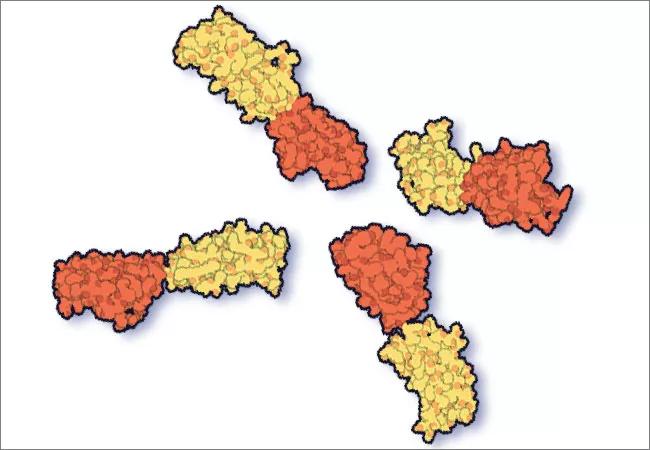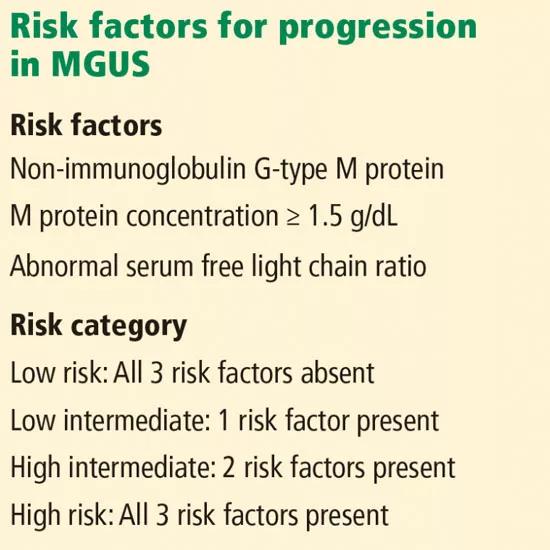Determining your follow-up strategy

By Jack Khouri, MD, Christy Samaras, DO, Jason Valent, MD, Alex Mejia Garcia, MD, Beth Faiman, PhD, CNP, Saveta Mathur, CNP, Kim Hamilton, CNP, Megan Nakashima, MD, Matt Kalaycio, MD
Cleveland Clinic is a non-profit academic medical center. Advertising on our site helps support our mission. We do not endorse non-Cleveland Clinic products or services. Policy
The monoclonal gammopathies encompass a number of disorders characterized by the production of a monoclonal protein (M protein) by an abnormal clone of plasma cells or other lymphoid cells. Monoclonal gammopathy of undetermined significance (MGUS) is the most common of these disorders. Its clinical relevance lies in the inherent risk of progression to hematologic malignancies such as multiple myeloma or other lymphoproliferative disorders, or of organ dysfunction due to the toxic effects of the M protein.
Research has helped to refine the diagnostic workup and recognize subsets of patients with MGUS at different risks of progression to myeloma and related disorders. Factors predicting progression are:
Based on these predictors, MGUS can be classified into four risk categories: low, low-intermediate, high-intermediate and high.

Half of patients with MGUS fall into the low-risk category, which is defined by IgG-type serum M protein in a concentration less than 1.5 g/dL and a normal serum free light-chain ratio (kappa-lambda 0.26–1.65). The absolute risk of progression at 20 years is only 5 percent for patients with low-risk MGUS, compared with 58 percent in patients with high-risk MGUS (positive for all three risk factors).
The presence of less than 10 percent plasma cells in the bone marrow is required to satisfy the definition of MGUS, but bone marrow biopsy can be omitted for patients with low-risk MGUS, given the slim chance of finding a significant percentage of clonal plasma cells in the marrow and the inherently low risk of progression. Skeletal surveys are often deferred for low-risk MGUS, but we obtain them in all our patients to ensure the absence of plasmacytomas, which need to be treated (typically with radiotherapy). Importantly, patients with unexplained bone pain (mostly in long bones, ribs and spine, whereas joints are not typically involved) and a normal skeletal survey should undergo advanced imaging (whole-body magnetic resonance imaging or whole-body positron emission tomography and computed tomography) to detect bone lesions otherwise missed on plain radiography.
Most of the recommendations regarding follow-up are based on expert opinion, given the lack of randomized data. Most experts agree that all patients should be reevaluated six months after an M protein is detected, with laboratory surveillance tests (complete blood cell count, serum creatinine, serum calcium level, serum protein electrophoresis and serum free light chains). Low-risk patients with a stable M protein level can be followed every two to three years.
Suspect malignant progression if the serum M protein level increases by 50 percent or more (with an absolute increase of ≥ 0.5 g/dL); the serum M protein level is 3 g/dL or higher; the serum free light-chain ratio is more than 100; or the patient has unexplained anemia, elevated creatinine, bone pain, fracture or hypercalcemia.
Patients at intermediate or high risk should be followed annually after the initial six-month visit.
A recent study highlighted the importance of risk stratification in reducing the costs associated with an overzealous diagnostic workup of patients with low-risk MGUS. These savings are in addition to a reduction in patient anticipation and anxiety that universally occur before invasive procedures.
Once an M protein is identified, a comprehensive history, physical examination and laboratory tests (serum protein electrophoresis to quantify the protein, serum immunofixation, serum free light chains, complete blood cell count, calcium and creatinine) should be done, taking into consideration the differential diagnosis of monoclonal gammopathies discussed in a previous post.
After MGUS is confirmed, the patient should be risk-stratified to determine the need for bone marrow biopsy and to predict the risk of progression to more serious conditions.
Referral to a hematologist is warranted for patients with intermediate- and high-risk MGUS, patients with abnormal serum free light-chain ratios and those who show evidence of malignant progression. Patients with intermediate- and high-risk MGUS could be referred for bone marrow biopsy before assessment by a hematologist. The primary care provider may continue to follow patients with low-risk MGUS who do not display clinical or laboratory evidence of myeloma or related disorders.
When light-chain amyloidosis, Waldenström macroglobulinemia or another M protein-related disorder is suspected, referral to subspecialists is advised to better define the correlation between the M protein and the patient’s symptoms and signs.
The importance of educating patients to report any new worrisome symptom (e.g., fatigue, neuropathy, weight loss, night sweats, bone pain) cannot be overemphasized, as some patients may progress to myeloma or other disorders between follow-up visits.
Dr. Khouri is a fellow in the Department of Hematology and Medical Oncology. Drs. Samaras, Valent and Mejia Garcia are staff in the Department of Hematology and Medical Oncology. Dr. Faiman, Ms. Mathur and Ms. Hamilton are clinical nurse practitioners in the Department of Hematologic Oncology and Blood Disorders. Dr. Nakashima is staff in the Department of Clinical Pathology. Dr. Kalaycio is Chairman of the Department of Hematology and Medical Oncology.
This abridged article was originally published in Cleveland Clinic Journal of Medicine.

An underdiagnosed condition in patients with cancer

Study demonstrates superior visualization of occult primary lesions

New device offers greater tumor control for malignant liver lesions

Cleveland Clinic researchers discover what drives – and what may halt – virus-induced cancer

First-ever U.S. population-level retrospective analysis reveals many patients with systemic mastocytosis need faster intervention

New program provides prehabilitation and rehabilitation services to help patients with cancer maintain and regain function

First-of-its-kind research investigates the viability of standard screening to reduce the burden of late-stage cancer diagnoses

Global R&D efforts expanding first-line and relapse therapy options for patients